Division of Parramatta
The Division of Parramatta is an Australian electoral division in the state of New South Wales. The division was created in 1900 and was one of the original 65 divisions contested at the first federal election. It is named for the locality of Parramatta. The name Parramatta has been sourced to an Aboriginal word for the area. The Darug people had lived in the area for many generations, and regarded the area as a food bowl, rich in food from the river and forests. They called the area Baramada or Burramatta ('Parramatta') which means "the place where the eels lie down".[1]
| Parramatta Australian House of Representatives Division | |
|---|---|
 Division of Parramatta in New South Wales, as of the 2016 federal election. | |
| Created | 1901 |
| MP | Julie Owens |
| Party | Labor |
| Namesake | Parramatta |
| Electors | 103,186 (2019) |
| Area | 57 km2 (22.0 sq mi) |
| Demographic | Inner Metropolitan |
The division is based in the western suburbs of Sydney. Besides Parramatta, it includes Camellia, Clyde, Constitution Hill, Dundas Valley, Granville, Harris Park, Holroyd, Mays Hill, North Parramatta, Oatlands, Rosehill, Rydalmere, Telopea, Wentworthville, Westmead; and parts of Carlingford, Dundas, Ermington, Guildford, Merrylands, North Rocks, Northmead, Old Toongabbie, Pendle Hill, South Granville, South Wentworthville, and Toongabbie.
The current Member for the Division of Parramatta, since the 2004 federal election, is Julie Owens, a member of the Australian Labor Party.
History
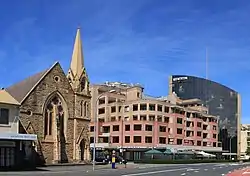
As originally created, it covered the outer northwestern suburbs of Sydney, though that city's dramatic growth made it an entirely urban seat after World War II. For most of the first seven decades after Federation, it included a large amount of conservative-leaning territory that usually swamped Parramatta itself, which has historically been a working-class area. As a result, the seat was held by the Liberals and their predecessors for all but one term from Federation until 1977.
A redistribution ahead of the 1977 election split Parramatta almost in half. Most of the wealthier eastern half became the comfortably safe Liberal seat of Dundas. Most of the western half, including the bulk of the Parramatta LGA, became the core of a marginal Labor seat that retained the Parramatta name, as per Australian Electoral Commission guidelines that require the names of original Federation electorates to be preserved where possible.[2][3] However, the reconfigured Parramatta was anchored in traditionally pro-Labor territory in western Sydney. Parramatta's Liberal incumbent, Phillip Ruddock, opted to follow most of his base into Dundas, allowing his 1975 challenger, John Brown to become only the second Labor member ever to win Parramatta.
Since then, it has been located between Labor's traditional heartland of western Sydney and the traditional Liberal stronghold of the North Shore. As a result, whenever the seat is redistributed, a shift of a few kilometres to the west or east can radically alter its political landscape.[4]
Most recently, the 2006 redistribution shifted Parramatta from marginally Labor to notionally marginally Liberal (as defined by the Australian Electoral Commission). Nevertheless, as was widely expected[5] at the 2007 federal election, the incumbent Labor member, Julie Owens, held the seat ahead of Liberal candidate Colin Robinson, a member of the Electrical Trades Union,[5] with an increased majority.
Owens has subsequently been re-elected at the 2010, 2013, 2016 elections, and 2019. Owens' win in the seat in 2004 marked the first time that the Liberals and their predecessors had won government without also winning Parramatta.
Prominent members of Parramatta over the years have included (Sir) Joseph Cook, a former Prime Minister; (Sir) Garfield Barwick and Nigel Bowen, both of whom served as Attorney-General before moving to senior judicial position, Barwick as Chief Justice of the High Court. Ruddock, a former Attorney-General and Immigration Minister also represented the seat (though he was the member for Berowra by then); as did Brown, a former Sports Minister.[4]
Members
| Image | Member | Party | Term | Notes | |
|---|---|---|---|---|---|
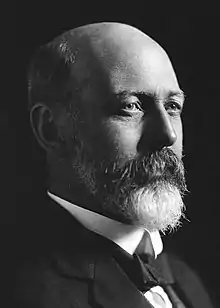 |
(Sir) Joseph Cook (1860–1947) |
Free Trade | 30 March 1901 – 1906 |
Previously held the New South Wales Legislative Assembly seat of Hartley. Served as Opposition Leader from 1908 to 1909, in 1913, and from 1914 to 1917. Served as minister under Deakin and Hughes. Served as Prime Minister from 1913 to 1914. Resigned in order to become the High Commissioner to the United Kingdom | |
| Anti-Socialist | 1906 – 26 May 1909 | ||||
| Commonwealth Liberal | 26 May 1909 – 17 February 1917 | ||||
| Nationalist | 17 February 1917 – 11 November 1921 | ||||
.jpg.webp) |
Herbert Pratten (1865–1928) |
Nationalist | 10 December 1921 – 16 December 1922 |
Previously a member of the Senate. Transferred to the Division of Martin | |
.jpg.webp) |
Eric Bowden (1871–1931) |
Nationalist | 16 December 1922 – 12 October 1929 |
Previously held the Division of Nepean. Served as minister under Bruce. Lost seat | |
 |
Albert Rowe (1872–1955) |
Labor | 12 October 1929 – 19 December 1931 |
Lost seat | |
 |
(Sir) Frederick Stewart (1884–1961) |
United Australia | 19 December 1931 – 21 February 1945 |
Served as minister under Lyons, Menzies and Fadden. Retired | |
| Liberal | 21 February 1945 – 16 August 1946 | ||||
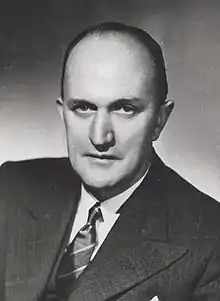 |
Howard Beale (1898–1983) |
Liberal | 28 September 1946 – 10 February 1958 |
Served as minister under Menzies. Resigned in order to become the Australian Ambassador to the United States | |
 |
Sir Garfield Barwick (1903–1997) |
Liberal | 8 March 1958 – 24 April 1964 |
Served as minister under Menzies. Resigned in order to become Chief Justice of the High Court | |
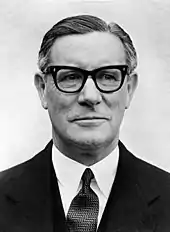 |
Nigel Bowen (1911–1994) |
Liberal | 20 June 1964 – 11 July 1973 |
Served as minister under Holt, McEwen, Gorton and McMahon. Resigned in order to become a Judge of the Supreme Court of New South Wales | |
 |
Philip Ruddock (1943–) |
Liberal | 22 September 1973 – 10 December 1977 |
Transferred to the Division of Dundas | |
 |
John Brown (1931–) |
Labor | 10 December 1977 – 19 February 1990 |
Served as minister under Hawke. Retired | |
 |
Paul Elliott (1954–) |
Labor | 24 March 1990 – 2 March 1996 |
Lost seat | |
 |
Ross Cameron (1965–) |
Liberal | 2 March 1996 – 9 October 2004 |
Lost seat | |
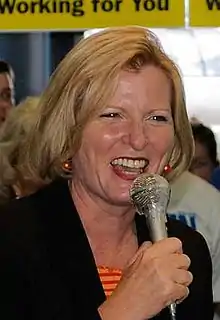 |
Julie Owens (1958–) |
Labor | 9 October 2004 – present |
Incumbent |
Election results
| Party | Candidate | Votes | % | ±% | |
|---|---|---|---|---|---|
| Labor | Julie Owens | 38,171 | 45.08 | −1.38 | |
| Liberal | Charles Camenzuli | 34,954 | 41.28 | +6.91 | |
| Greens | Phil Bradley | 6,131 | 7.24 | +0.36 | |
| Christian Democrats | Asma Payara | 2,526 | 2.98 | −2.32 | |
| United Australia | Ganesh Loke | 2,186 | 2.58 | +2.58 | |
| Socialist Equality | Oscar Grenfell | 702 | 0.83 | +0.83 | |
| Total formal votes | 84,670 | 91.63 | +0.89 | ||
| Informal votes | 7,739 | 8.37 | −0.89 | ||
| Turnout | 92,409 | 89.61 | +0.59 | ||
| Two-party-preferred result | |||||
| Labor | Julie Owens | 45,302 | 53.50 | −4.17 | |
| Liberal | Charles Camenzuli | 39,368 | 46.50 | +4.17 | |
| Labor hold | Swing | −4.17 | |||
References
- Troy, Jakelin. "The Sydney Language". Macquarie Aboriginal Words. Sydney: Macquarie Library. p. 76.
- "Archived copy". Archived from the original on 10 May 2017. Retrieved 8 March 2018.CS1 maint: archived copy as title (link)
- "Archived copy". Archived from the original on 10 May 2017. Retrieved 8 March 2018.CS1 maint: archived copy as title (link)
- Green, Antony (2010). "Parramattta". Australia votes 2010. Australian Broadcasting Corporation. Archived from the original on 7 February 2012.
- Carr, Adam (2007). "Division of Parramatta". Guide to the 2007 Federal Election. Archived from the original on 13 September 2007. Retrieved 22 September 2007.
- Parramatta, NSW, Tally Room 2019, Australian Electoral Commission.